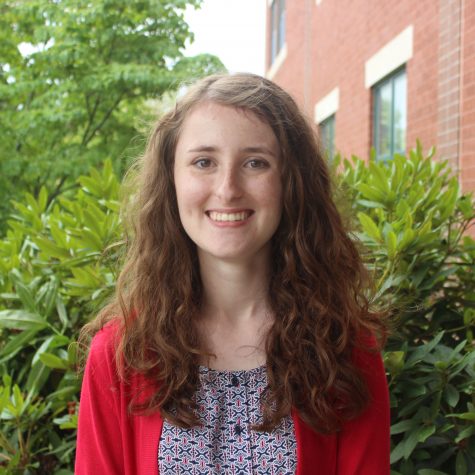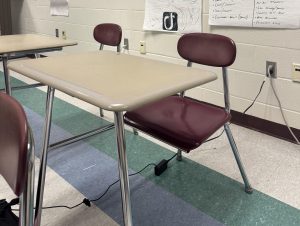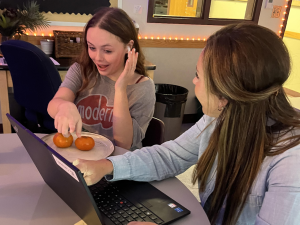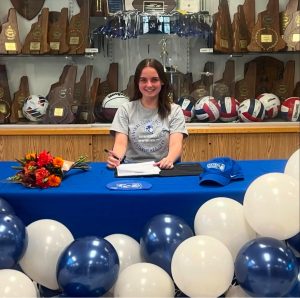In with the new (SATs, that is)
January 26, 2016
With spring standardized testing fast approaching, students and teachers alike are bracing themselves for the changes that are coming to the SAT. Well, some are. A big issue is that most people only have a vague idea of what the changes are and why they were implemented.
This year, the new SATs are being distributed to all juniors on March 2nd, replacing the multitude of standardized tests that they were subjected to in previous years.
“In the past we’ve had three days of math, the NECAP testing plus another two to three days of science,” said Principal Richard Barnes. “We’ve been pushing for a long time as principals and Superintendents that if we’re going to test kids, let’s give them something that’s relevant to them and actually has some meaning, because we know it’s tough to ask you guys to do more work on something that has no real value academically for you.”
Originally, juniors would take both the NECAP test and the Smarter Balanced tests, all of which measured academic performance in reading, math, and science. Hollis Brookline realized that the types of questions asked on these assessments did not provide the information they were looking for in terms of student evaluation. Many schools in the state also had the same issue. These schools — including Hollis Brookline High School — have decided to make the SAT their state test instead. Barnes believes that the changes to the test will help to make it a fair, more relevant assessment.
“It’s certainly better on our end, because we’re going to be able to get information,” Barnes continued. “When we see a result from that, we can say ‘well yeah, that’s directly related to the work we do in school,’ versus ‘I can’t say one way or the other if that’s related to the work we do in school,’ or ‘the kid worked really hard, is naturally smart on their own, and paid for this really expensive test prep that helped them.’ This, I think, does connect a curriculum.”
This is because the new SAT will focus less on basic memorization and problem solving skills, and more on applying your knowledge to problems based on real life situations.
Let’s break down the changes to each section.
The reading and writing portions will be combined into one Evidence Based Reading and Writing section. There will still be passages you must read and questions to answer afterward, but the focus of the questions have shifted. As opposed to asking the meaning of vocabulary words, the questions will be geared toward applying and synthesizing your knowledge from the passage, and figuring out how words and phrases fit together. There will be a lot of emphasis on using supporting evidence from a multitude of sources. Within the reading section there will also be a small portion dedicated to writing.
The essay portion has been redesigned as well. It will still be offered, however it is optional. (If you choose to take the essay portion in March, you will have to pay around $11. Bear in mind this will lengthen the test to about five hours.Without the essay, the test is about three hours).
“[The essay] looks much better than, say, ‘talk about capital punishment.’ It’s beyond that and looks a lot more like what you would be asked to do on an AP prompt, where it’s saying ‘here’s what we’re looking for, here’s the text, and here’s how we want you to analyze what you saw here,’ which is very different than ‘give me your opinion on something,’” Barnes said of the new essay.
The prompts will focus on close reading and analysis of an author’s work.
If you’re not a writer, you may not need to worry too much, because it could potentially not have a large impact. The guidance department found this year that the top twenty colleges which HB sends its students to have said they are not going to use the essay in the application process this year, or are undecided.
The theme of applying and synthesizing your knowledge carries over into the math section as well. There will be fewer word problems, however, the questions will require the application of knowledge gained through reading charts and graphs much like what you would see in college and the real world, as well as a mastery of complex equations.
“They’re looking to test kids on experiences they already have in their classroom and the ones that they’re likely to encounter in college. In the past it was people who were paid to design questions that were tested over and over again, but they weren’t specific,” Barnes said.
Speaking of college, many students are wondering about the impact of submitting the two versions of the SAT to their colleges of choice. Will they be superscored together? The simple answer is, no one is sure yet.
HB Guidance Counselor KC Maynard said, “The College Board is saying that they don’t superscore them with the old. However, individual colleges may still select to superscore. Quite frankly, I’m not yet sure that there’s enough information out there to be very accurate. It might be one of those, ‘it depends!’”
Barnes agreed, adding that “A lot of this is coming down really recently even from the state level in terms of implementing at the high school. We’ve had maybe a month of knowledge that’s coming and maybe a week of actually dealing with the materials.”
There are still some unanswered questions, but the changes that are coming to the SATs are showing potential to be a much-needed and positive shift.













